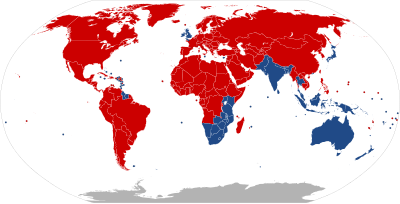Left- and right-hand traffic
The driving side of a road is the side where vehicles must drive. Each country says whether vehicles will drive on the right-hand or left-hand side of the road.[1] This is sometimes called the rule of the road.[2] This basic rule makes traffic move more easily. It also lowers the risk of head-on collisions. Today about 66.1% of the world's people live in countries that drive on the right-hand side; 33.9% live in countries that drive on the left-hand side.[3]


The side driven on is usually the other side from which a vehicle's steering wheel and instrument panel are located. That is, right-hand drive vehicles are normal when driving on the left-hand side of the road, and left-hand drive vehicles are used when driving on the right-hand side of the road.
Most countries that drive on the left-hand side are former British colonies. Some other countries chose the left-hand side of the road. These countries include: Japan, Pakistan, India, Thailand, Nepal, Bhutan, Mozambique, Suriname, East Timor, Indonesia, and more. Today, only four European countries drive on the left-hand, the United Kingdom, Ireland, Malta, and Cyprus. There are several countries where their territories that exist outside the mainland drive on a different side from the mainland. One well-known example is that all of China drives on the right-hand except for its Special Administrative Regions Hong Kong and Macau, which drive on the left-hand.
Before the creation of the automobile, people mostly rode on the left-hand side, since most people were right-handed and would whip their horses with their left hands. Warriors in battle could also use their right hand to hold and control their weapon.[4] During the 1700s, many farmers began to pull their vehicles using teams of horses rather than just one. In 1794, France passed the first right-hand driving laws, and this law would spread with Napoleon's conquests.[5] The territories and regions of the former Austro-Hungarian and Portuguese Empires refused to change the direction of driving at first, but most eventually chose to drive on the right-side. Only Mozambique, East Timor, and Macau (all former Portuguese colonies) still drive on the left-side.[5] Canada, Myanmar, Gibraltar, British Indian Ocean Territory, Belize, and a few countries in West Africa like Ghana, Nigeria, Sierra Leone, and The Gambia all switched to driving on the right hand side of the road.
References
change- ↑ Draper, Geoff (1993). "Harmonised Headlamp Design for Worldwide Application". Motor Vehicle Lighting. Society of Automotive Engineers. pp. 23–36.
- ↑ Kincaid, Peter (December 1986). The Rule of the Road: An International Guide to History and Practice. Greenwood Press. ISBN 0-313-25249-1.
- ↑ Lucas, Brian (2005). "Which side of the road do they drive on?". Retrieved 2006-08-03.
- ↑ Dan Stone, Dan Stone (2013-05-31). "The Right (and Left) Stuff: Why Countries Drive on Different Sides of the Road". National Geographic Society (blogs). Retrieved 2017-06-27.
- ↑ 5.0 5.1 John (2013-02-22). "Why Does Japan Drive On The Left Side of the Road?". Tofugu. Retrieved 2017-06-27.